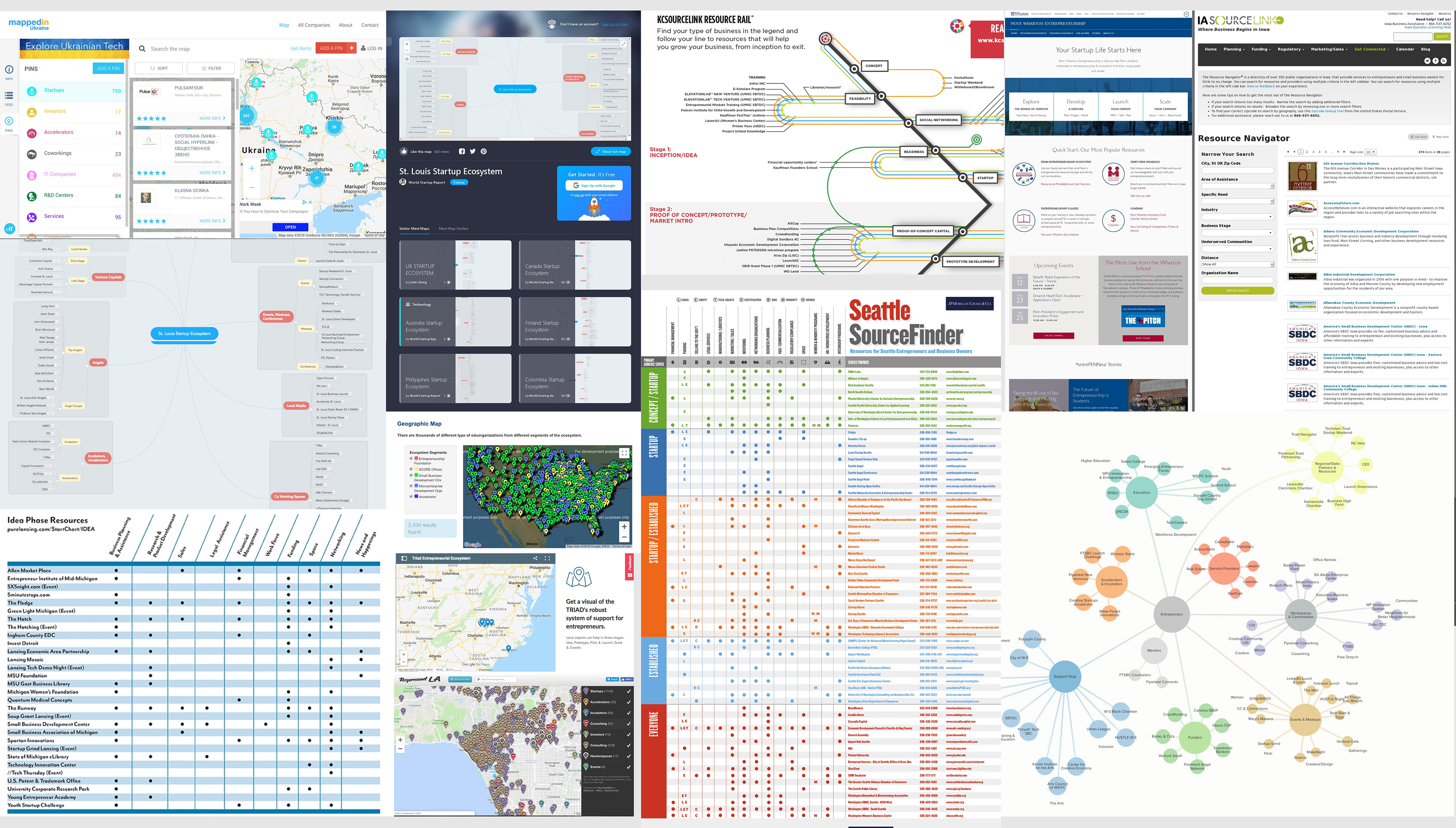Ecosystem Mapping Joel Bennett | Laura Black January 10, 2019
Wake Forest Entrepreneurship Center WS/FC Ecosystem Partners Meeting
Project brief asked for an interactive map of the resources available to local entrepreneurs.
[ From the Project Brief ]
Overview:
HUSTLE W-S seeks to coordinate a design thinking project to assist the WS/FC Ecosystem Partners in the development of a dynamic map of the growing organizations and supports available to the diverse community of local entrepreneurs.
The process will include the 5 phases of the traditional design thinking model: Planned project elements include project development, a 2-day ecosystem partner retreat, and the development/design of an actual prototype created by local artists and designers in the ecosystem.
The project will include, engage and/or benefit the Center for Design Innovation, the Center for Creative Economy, and local creative professionals, along with the broader entrepreneurial ecosystem.
Phase 4 - Prototype:
UX/UI Design has emerged as a key need for local entrepreneurs and tech companies and our ecosystem does not have enough designers to meet the current and emerging need. This phase of the project will involve the creative and technical development process of the ecosystem map(s) prototyped in the retreat.
This may include elements such as a website, app, and/or printed versions of a map for use by entrepreneurs and partners. Drafts will be releases for review and approval by the Ecosystem Partner group, with the goal of completion by end of 2018.
We will engage a local User Interface/User Experience Designer, as the project lead. He will work with an HUSTLE intern (a local artist/designer and aspiring entrepreneur) throughout the process. The internship/training process will be documented and serve as a prototype for a potential future UX/UI Design program.
Project Goals:
• To engage the local ecosystem partners in creative and design-thinking process that will transform their approach to working together
• To introduce the partnership to the empowering work of the Kauffman Foundation and their approach to inclusive and entrepreneur-centric ecosystem development
• To model and promote diverse and inclusive leadership within the ecosystem and to eliminate silos
• To model and promote the integration of artistic practices and creative professionals as a means to improve communication and community engagement
• To grow empathy for the entrepreneur as the center of planning as the partner group works together and grows
• To create an empathetic and positive environment for the promotion of collective impact and network leadership.
• To develop a basic prototype for an interactive ecosystem map, utilizing local creative talent
• To highlight User Interface and User Experience Design as a potential new creative work sector in the community
The following are some artifacts from the discovery Phase.
We began with the question: "Does an ecosystem need a map?"
Many, many models (possibly hundreds?) and varieties exist.

And then we asked: "What is an ecosystem?"
Maybe a better question: Who is an ecosystem?
Empathy?
Triad Entrepreneur Alliance meeting: December, 2018
"We observed a group consensus, and a passionate discussion on Ecosystem Mapping from the attendees, all of whom represented Entrepreneur Support Organizations"
They were all looking for as a solution but we did not hear anyone express a specific problem.
Defining the problem: 2.0
Key stakeholders are the mapping project funders.
Entrepreneurial Support Organizations (ESOs) serve entrepreneurs providing services and resources such as: business plan development, professional coaching, legal structuring and access to capital.
They exist to serve entrepreneurs by providing support, preparing them through practice and continued service development as they grow.
Growth is symbolized as milestones along a timeline A - B - C - D (below).
Entrepreneurs connect to ESOs and receive these different resources throughout their entrepreneurial journey. The entrepreneurs enter the ecosystem in different places with needs based upon their individual experience and maturity.]
Entering the funnel, entrepreneurs first EXPLORE the ecosystem, and then PREPARE to start-up and then ultimately DEVELOP and Grow.
Entrepreneurial Support Organizations engage and serve at each stage. ESOs receive their operational funding through foundational grants, municipal line budgets and other charitable community and economic development resources.
The prevailing KPI of an ESO's effectiveness is often the number of entrepreneurs they served and a some qualification based upon loosely defined outcomes of the entrepreneurs.
So in a perfect world, this service delivery might look something like this:We refined our objectives by revisiting the original project brief:
Discovery: Map 1
Forsyth County/Winston Salem Entrepreneurial Ecosystem
Discovery: Map 2
Forsyth County/Winston Salem Entrepreneurial Ecosystem
Discovery: Map 3
Forsyth County/Winston Salem Entrepreneurial Ecosystem
Re-Define the problem: 2.1
Forsyth County/Winston Salem Entrepreneurial Ecosystem
They exist to serve entrepreneurs providing support, preparing through practice and continued development as they grow.
Growth is seen as milestones along a timeline A - B - C - D
Entrepreneurs connect to ESOs and receive these different resources that are made available through their entrepreneurial journey.
The confusion has to be sorted out by the entrepreneur.
We heard over and over the difficulty and frustration of wasting time looking for the services they needed - only to find out that the ESO was not the best fit for their needs.
Which ESO program is right for me?
Forsyth County/Winston Salem Entrepreneur
User Journey Mapping
Early UX and UI
User Experience Design:
Informed Context, Systems Thinking, Objective Definition
Concept Design
Design Refinement
User Flow, Keystone States, Nomenclature and Symbol Hierarchy
Prototype v1.0
A mobile first, smart web app that delivers recommended events, programs and connections such as mentors, peers and resources to entrepreneurs and community members based on simple three step process qualification. User driven... the experience is designed to emphasize the users needs and to share their personal experiences with their peer group and potential partners.